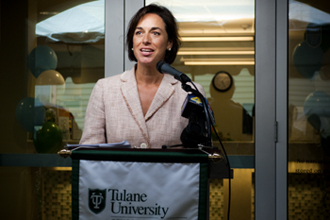New Orleans makes healthcare strides since Katrina
In the nearly seven years since Hurricane Katrina, New Orleans has made “amazing progress” in developing a sophisticated system that provides primary care to thousands of citizens, says Dr. Karen DeSalvo, a Tulane University alumna who serves as health commissioner for the City of New Orleans.

Dr. Karen DeSalvo speaks at the June dedication of a new Tulane healthcare facility located in the Mid-City neighborhood of New Orleans. Both within and outside of her role as health commissioner for the City of New Orleans, DeSalvo has worked toward creating a sustainable, accessible network of neighborhood-based “medical homes” for citizens. (Photo by Paula Burch-Celentano)
After the devastation in 2005, DeSalvo and other healthcare experts worked to develop a new system of primary health care, one structured around neighborhood-based “medical homes.”
Currently there are about 88 community health clinics in New Orleans, servicing about 175,000 patient visits per year and serving about 20 percent of the city's population. In addition, New Orleans has been selected as one of 17 communities in the United States to receive federal funding for a pilot project to link electronic health records.
“It was a chance to re-set the dial ⦠to demonstrate that primary care has value,” says DeSalvo, who earned both her medical degree and a master of public health degree from Tulane.
DeSalvo was vice dean for community affairs and health policy at the Tulane School of Medicine before she was tapped for the city's top health post in December 2010.
“Basic primary care can be very cost-effective,” says DeSalvo. While primary care services and medications cost on average $600 per person for one year, the average cost for one emergency department visit is $600.
The remaining challenge, DeSalvo says, is to identify sustainable funding to provide a revenue stream for the community-based primary care clinics.
Sometimes community clinics must wait six months to be reimbursed for service they have provided, says DeSalvo. “How do you get the money from the bank account to the street, so that the providers and the patients can keep doing what they want to do to stay healthy?”
